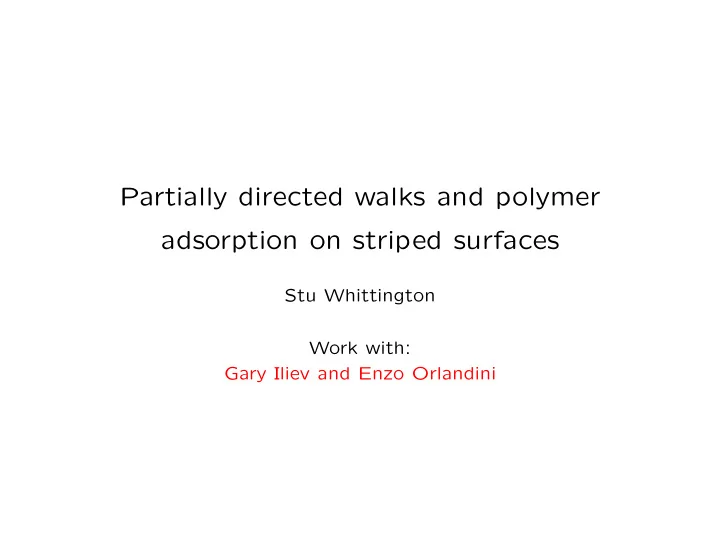

Partially directed walks and polymer adsorption on striped surfaces Stu Whittington Work with: Gary Iliev and Enzo Orlandini
The physical problem Polymer adsorption 1. A polymer in dilute solution can adsorb at an impenetrable surface 2. For an infinite polymer there will be a phase transition from an adsorbed phase to a desorbed phase at some characteristic temperature 3. For an adsorbed polymer, the polymer can be desorbed by application of a force 1
The idea behind AFM 2
Partially directed walks in three dimensions Vertex weighting = + + + P ( a, z ) = 1 + 2 azP ( a, z ) + az 2 ( P (1 , z ) − 1)(1 + 2 azP ( a, z )) √ P ( a, z ) has two physically relevant singularities, z = z 1 = ( 17 − 3) / 4 and a pole at z = z 2 ( a ). z 1 dominates for small a and z 2 ( a ) dominates for large a . 3
Partially directed walks in three dimensions Pulling vertically = + + F ( a, y, z ) = P ( a, z )(1 + 2 ayz 2 F (1 , y, z )) + yzF (1 , y, z ) √ F ( a, y, z ) has three relevant singularities, z 1 = ( 17 − 3) / 4, and two poles z 2 ( a ) and z 3 ( y ). 4
The connection to thermodynamics If we write w n ( v, h ) for the number of walks with n edges, v + 1 vertices in the surface ( visits ) and last vertex at height h then the partition function is w n ( v, h ) a v y h � Z n ( a, y ) = v,h where a = exp( − ǫ/kT ) and y = exp( f/kT ). The limiting free energy n →∞ n − 1 log Z n ( a, y ) κ ( a, y ) = lim exists and Z n ( a, y ) z n = e [ κ ( a,y ) n + o ( n )] z n � � F ( a, y, z ) = n n 5
e [ κ ( a,y ) n + o ( n )] z n � F ( a, y, z ) = n which is singular at z = z c ( a, y ) = exp( − κ ( a, y )) so κ ( a, y ) = − log z c and the singularity structure determines the thermodynamics. 6
Force–temperature diagram for pulling vertically 1.5 1 f 0.5 0 0 1 2 3 4 Τ 7
Pulling at an angle If we want to pull at an angle we have to keep track of all the coordinates of the last vertex to track the response to the applied force. = + + + P ( a, y 1 , y 2 , z ) = 1 + a ( y 1 + y 2 ) zP ( a, y 1 , y 2 , z ) az 2 ( P (1 , y 1 , y 2 , z ) − 1)(1 + a ( y 1 + y 2 ) zP ( a, y 1 , y 2 , z )) + 8
Pulling at an angle = + + F ( a, y 1 , y 2 , y 3 , z ) = P ( a, y 1 , y 2 , z )(1 + a ( y 1 + y 2 ) y 3 z 2 F (1 , y 1 , y 2 , y 3 , z )) + y 3 zF (1 , y 1 , y 2 , y 3 , z ) 9
Singularities of F ( a, y 1 , y 2 , y 3 , z ) • F ( a, y 1 , y 2 , y 3 , z ) has three relevant singularities, a branch cut z 1 ( y 1 , y 2 ), and two poles z 2 ( a, y 1 , y 2 ) and z 3 ( y 1 , y 2 , y 3 ). • z 2 ( a, y 1 , y 2 ) controls the adsorbed phase and z 3 ( y 1 , y 2 , y 3 ) controls the desorbed phase in the presence of a force that can desorb the walk. • The phase boundary is determined by the condition z 2 = z 3 . 10
Pulling on a striped surface f θ a b a b a b a b 11
Mapping to a bicoloured PDW 12
Factorization scheme for a striped surface This requires keeping track of the parity of the number of steps parallel to the surface, in the direction perpendicular to the stripe direction, since we need to know if we have followed a stripe or crossed from one stripe to another. 13
Factorization scheme for a striped surface 14
Homopolymer on a striped surface Pulling normal to surface – top curve is for a homogeneous surface 15
θ = π/ 3, φ = 0 16
θ = π/ 3, φ = π/ 2 17
Alternating copolymers on a striped surface a b a b a b a b 18
Alternating copolymers on a striped surface • Now we have inhomogeneity in both the polymer and the sur- face. We also have to keep track of the parity of the number of edges in the walk. This introduces new complications but can be handled. • Inhomogeneity in both the polymer and the surface gives a crude model of recognition. 19
Recommend
More recommend